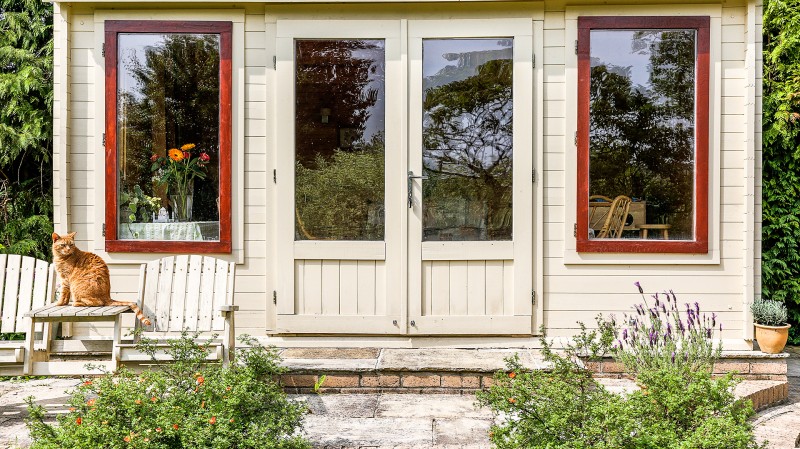You are here: Do I need planning permission for a Garden Room?
During the recent pandemic, the restrictions placed on travelling to work have meant that people up and down the country have been faced with the prospect of working from home. To work from home efficiently means finding a dedicated space to work from. Dining room tables or kitchen worktops are not ideal – especially if Zoom meetings are involved.

While some are keen to get back to the office or place of work, others are finding that home working gives them some better lifestyle choices and many are finding that their employers are actively encouraging them to continue working from home with the odd visit to the workplace.
This presents a dilemma for some, contemplating where they can find that all important dedicated space for work. There are a variety of solutions, attic conversions are an option as is moving to a larger house with a spare bedroom. Both of those require a substantial financial investment and moving house brings other important considerations, such as schools for those with young families.
There is, however another option, building a garden room to use as an office.
A garden office can be made very comfortable with an electricity supply allowing adequate heating and lighting as well as extremely functional with all the necessary office furniture and an internet connection allowing access to the world at large.
There is also a psychological benefit to an office which it is outside the family home. You have to leave home, shut the door, walk to your office and sit at your desk away from the temptation to get involved in family affairs during working hours. You are no longer at home, you are in your office.
Most garden rooms don't even require planning permission, providing they fall within permitted development guidelines and permitted development rights are available on the property.
You may not have permitted development rights if:
- you live in a listed building of a conservation area
- you live in an area designated as a National Park, area of outstanding natural beauty or World Heritage Site
- the Local Authority has removed permitted development rights by a condition on a previous planning consent or by an Article 4 direction under article 4 of the General Permitted Development Order which enables the Secretary of State or the local planning authority to withdraw specified permitted development rights across a defined area.
It is always better to check the status of permitted development rights before starting a development.
Garden rooms are classed as outbuildings, so you're allowed to build one as long as you comply with certain rules.
If you want to build a garden room under permitted development, it needs to comply with the following;
- Your garden room should not be built on the front elevation of the property, nor should it protrude beyond the line of build of the front of the original house. If you, or a previous owner, have extended the property at any time, then the front refers to how it stood on 1 July 1948.
- The total area of all extensions and outbuildings, including your proposed garden room, should not exceed 50% of the total area of land around the house.
- The garden room should be single storey with a maximum height of 3 metres, or 4 metres if it has a dual-pitched roof. The eaves being no more than 2.5 metres above ground level.
- If it is built less than 2 metres from your boundary, the maximum permitted height is 2.5 metres
The other legal restriction to consider is that of compliance with building regulations and again size matters as does location.
- If the internal floor area is less than 15sq metres, building regulations will not normally apply.
- Between 15sq metres and 30sq metres, building regulation compliance is required if the garden room is built less than a meter from a boundary or it is not constructed substantially of non-combustible materials. A mainly wooden structure for instance, would usually require to comply with building regulations.
- A garden room larger than 30sq metres would require to comply with UK building regulations.
In all cases, building regulations are required if the building contains any sleeping accommodation.
Many garden offices come prewired with electric wiring and sockets, however if your garden office is not a custom built structure this may not be the case and you may require an electrician to install a consumer unit and sockets for you along with necessary cabling to give you an internet connection.
Regardless of how the electrics are installed, your home office will need to be connected to the main electricity supply to your house. While it is possible to run a cable over ground, it is not the recommended solution. An underground installation, provided it is done properly, is by far the better option. This will involve digging a trench approximately 500 - 750mm deep to house a heavy duty armoured cable, which should be installed by a qualified electrician, although to cut costs you can dig the trench. All of this electricity supply must be installed and certified by the installing electrician as being in accordance with Part P Electrical Safety work regulations.
Regardless of whether you buy a top of the range custom built garden office, or opt for a solution which is kinder to the budget, you will have all the benefits of not having to share your working space with others, who will create the normal household noise and distractions. Nor will you have the hassles of the daily commute, just a leisurely stroll down to your office at the bottom of the garden.
If you are looking to make some home improvements, you may find some of these services useful
Builders
Find local help with a building project
Building Regulations
Find details of local experts who can help with Building Regulations
Architectural Design Services
Find local Architectural Design experts
Structural Inspections
Find an expert to carry out a structural inspection
Building Surveys
I want a local surveyor to do a Building Survey for me
Choose which Architectural service you require
If you are not sure which service you require, check out the options available...


